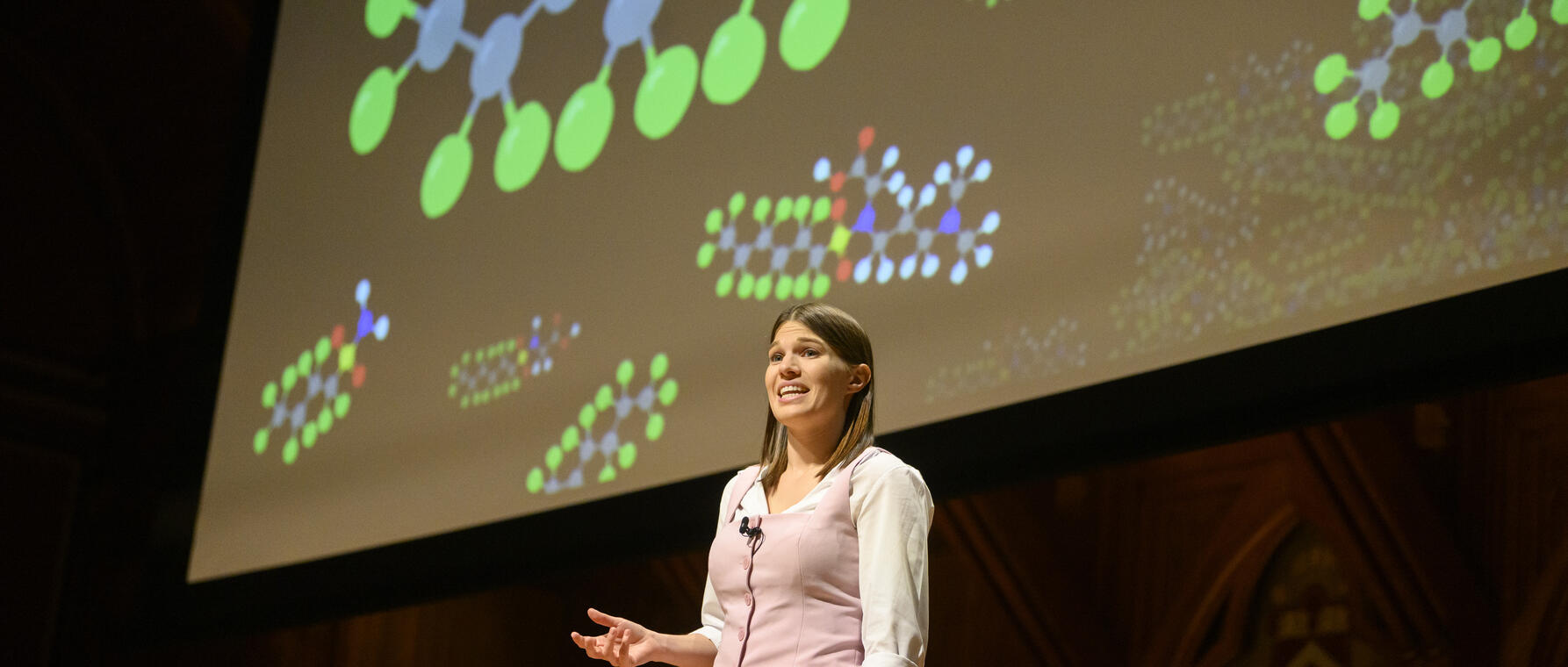Colloquy Podcast: The ‘Invisible Threat’ Contaminating Our Water

Research at Risk: Since World War II, universities have worked with the federal government to create an innovation ecosystem that has yielded life-changing progress. Now much of that work may be halted as funding is withdrawn. Find out more about the threats to medical, engineering, and scientific research, as well as how Harvard is fighting to preserve this work—and the University's core values.
Per- and polyfluoroalkyl substances (PFAS) are persistent, they’re everywhere, and they're probably bad for you. One of the detrimental health effects associated with the chemical compounds include liver disease, decreased fertility and hypertension in pregnant women, immune and developmental effects in children including decreased antibody response to vaccines, and certain organ cancers. In this talk, delivered in April 2024 at the annual Harvard Horizons Symposium, scientist Heidi Pickard, PhD '24, uncovers the prevalence of PFAS as well as their impact on the environment and health.
This transcript has been edited for clarity and correctness.
Ever wonder what makes your jacket waterproof or your fast food packaging grease-proof or what keeps your eggs from sticking to your nonstick cookware? It's all thanks to synthetic PFAS chemicals that give these products their desirable properties. But the same properties that make PFAS useful also make them dangerous.
PFAS is the term for a group of human-made chemicals called per- and polyfluoroalkyl substances. They're also known as "forever chemicals" because they never fully break down. They persist because of their unique chemical structure.
PFAS are defined by a stable, difficult-to-break tail of carbon-fluorine bonds connected to a partially degradable headgroup. And you can have many variations of these. Tens of thousands of PFAS now exist.
And the extensive persistence and production of these chemicals has led to global contamination and rampant accumulation in our environment and our bodies. PFAS are in the blood of every single one of us in this room. And exposure to PFAS has been linked to many adverse health effects including harm to the immune system, liver and thyroid disease, and certain cancers.
But these effects have only been assessed for a few well-studied PFAS. And, for most, there are no regulations. Industry continually produces new PFAS. But without the ability to detect many of these new chemicals, we are left with this invisible threat.
That's where my graduate research comes in. As a PhD candidate in environmental engineering, I use both field and lab measurements to investigate our exposure to new PFAS that pollute our water and food. I'm what you might call a chemical detective. Or, according to my friend who created a comic series about me, I'm also known as Hydro Heidi.
While PFAS are known for contaminating our drinking water, my research shows that consuming seafood may also expose us to concerning levels of these chemicals. I've been investigating major sources of high PFAS exposure for seafood consumers.
Firefighting foams are one of these major sources as they contain high concentrations of many different PFAS and are used for combating fuel-based fires. These foams are used at basically every military base and airport in the country, making them one of the largest sources of PFAS contamination nationwide.
When these foams are deployed to put out a fire, they lead to downstream contamination as PFAS in the foams infiltrate the soil, gradually seeping into groundwater that feeds into surface waters where they then accumulate in fish that are caught and consumed by recreational fishers and indigenous communities.
I've been investigating persistent PFAS contamination downstream of a military base in Massachusetts that historically used these firefighting foams. I collected various fish species from four sites going downstream of the base where people commonly fish. I then took these fish back to the lab and spent many months developing methods to extract and analyze them for all the different PFAS.
I first measured these fish for PFAS, which can be quantified with targeted analysis. This is the common method used by government labs to measure well-studied PFAS, which covers less than 1 percent of all PFAS that exist.
In this graph, I'm showing you blue bars that represent the average concentration of those few well-studied PFAS in fish species grouped by the four sites as you go downstream. You can see that further from the source, concentrations do decrease. But most of these fish have high levels, indicating that even eating one fish per month can lead to high PFAS exposure.
But the question is are we capturing all of the PFAS with this common method or are there other PFAS that may pose a risk that we cannot detect with this method? That's what I set out to figure out.
Using this ion chromatograph instrument, I measured for organic fluorine, which is a proxy for total PFAS because it captures anything with that carbon-fluorine bond, which all PFAS have. Using this method, I detected even higher concentrations of PFAS in these fish, shown in green, of which those well-studied PFAS only accounted for about half. This means targeted analysis underestimates contaminant exposure.
But I don't know what the specific chemicals are that make up this unknown fraction. That's where my third method comes in.
Using this non-targeted instrument, I can identify the specific chemicals that make up this fraction. I identified that there is one type of chemical shown in red that accounts for a lot of that fraction especially in fish closest to the contamination source. But this chemical is not regulated and rarely measured by other labs.
My research shows that additional methods are needed to understand which chemicals accumulate in fish. By identifying the prevalence of this new type of PFAS, my work can help other labs better quantify PFAS contamination by incorporating this chemical into routine monitoring and help government agencies more effectively mitigate exposure to the major PFAS of concern for fish-consuming communities.
As I conclude, I want to emphasize that scientists like myself are making significant progress in addressing the PFAS crisis. But there are also actionable steps you can take to mitigate your own exposure.
If you fish recreationally, check to see if an advisory exists in your area. Filter your drinking water and purchase products labeled as PFAS-free.
Finally, engage with your state government and advocate for better chemical regulations. Together, we can combat this invisible threat and reduce our exposure to these harmful chemicals.
Get the Latest Updates
Join Our Newsletter
Subscribe to Colloquy Podcast
Simplecast




